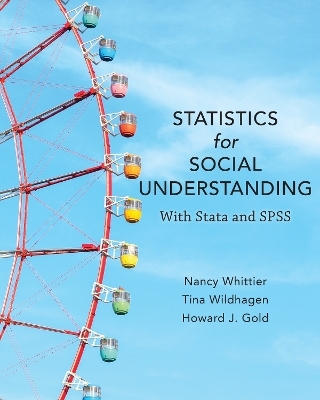
Statistics for Social Understanding
Rowman & Littlefield (Verlag)
978-1-5381-0983-0 (ISBN)
Statistics for Social Understanding: With Stata and SPSS introduces students to the way statistics is used in the social sciences--as a tool for advancing understanding of the social world. Written in an engaging and clear voice and based on the latest research on the teaching and learning of quantitative material, the text is geared to introductory students in the social sciences, including those with little quantitative background. It covers the conceptual aspects of statistics even when the mathematical details are minimized. Informed by research on teaching and learning in statistics, the book takes a universal design approach to accommodate diverse learning styles. With an early chapter on cross-tabulation, a focus on comparisons between groups throughout, and a unique chapter on causality, the text shows students the power of statistics for answering important real-world questions.
By providing thorough coverage of social science statistical topics, a balanced approach to calculation, and step-by-step directions on how to use statistical software, authors Nancy Whittier, Tina Wildhagen, and Howard J. Gold give students the ability to analyze data and explore and answer exciting questions.
To accommodate changing undergraduate courses, the text incorporates examples from both Stata and SPSS in every chapter and provides practice problems of every type as well as readily available datasets for classroom use, including the General Social Survey, American National Election Study, and more. Each chapter concludes with a chapter summary, a section on using Stata, a section on using SPSS, and practice problems.
Nancy Whittier is Sophia Smith Professor of Sociology at Smith College. She has taught statistics and research methods for 25 years, and also teaches classes on gender, sexuality, and social movements. She is the author of Frenemies: Feminists, Conservatives, and Sexual Violence (Oxford University Press, 2018), The Politics of Child Sexual Abuse: Emotions, Social Movements, and the State (Oxford University Press, 2009) and numerous articles on social movements, gender, and sexual violence. Tina Wildhagen is Associate Professor of Sociology and Dean of the Sophomore Class at Smith College. She has taught statistics and quantitative research methods for more than a decade, and also teaches courses on privilege and power in American education, inequality in higher education. Howard J. Gold is Professor of Government at Smith College. He has taught statistics for 30 years, and also teaches courses on American elections, public opinion and the media, and political behavior. His research focuses on public opinion, partisanship, and voting behavior.
Preface
About the Authors
Chapter 1 Introduction
Why Study Statistics?
Research Questions and the Research Process
Pinning Things Down: Variables and Measurement
Units of Analysis
Measurement Error: Validity and Reliability
Levels of Measurement
Causation: Independent and Dependent Variables
Getting the Data: Sampling and Generalizing
Sampling Methods
Sources of Secondary Data: Existing Data Sets, Reports, and “Big Data”
Big Data
Growth Mindset and Math Anxiety
Using This Book
Statistical Software
Chapter Summary
Using Stata
Using SPSS
Practice Problems
Chapter 2 Getting to Know Your Data
Frequency Distributions
Percentages and Proportions
Cumulative Percentage and Percentile
Percent Change
Rates and Ratios
Rates
Ratios
Working with Frequency Distribution Tables
Missing Values
Simplifying Tables by Collapsing Categories
Graphical Displays of a Single Variable: Bar Graphs, Pie Charts, Histograms, Stem-and-Leaf Plots, and Frequency Polygons
Bar Graphs and Pie Charts
Histograms
Stem-and-Leaf-Plots
Frequency Polygons
Time Series Charts
Comparing Two Groups On the Same Variable Using Tables, Graphs, and Charts
Chapter Summary
Using Stata
Using SPSS
Practice Problems
Chapter 3 Examining Relationships between Two Variables
Cross-Tabulations and Relationships between Variables
Independent and Dependent Variables
Column, Row, and Total Percentages
Interpreting the Strength of Relationships
Interpreting the Direction of Relationships
Graphical Representations of Bivariate Relationships
Chapter Summary
Using Stata
Using SPSS
Practice Problems
Chapter 4 Typical Values in a Group
What Does It Mean to Describe What Is Typical?
Mean
Median
Mode
Finding the Mode, Median, and Mean in Frequency Distributions
Choosing the Appropriate Measure of Central Tendency
Median Versus Mean Income
Chapter Summary
Using Stata
Using SPSS
Practice Problems
Chapter 5 The Diversity of Values in a Group
Range
Interquartile Range
Standard Deviation
Using the Standard Deviation to Compare Distributions
Comparing Apples and Oranges
Skewed Versus Symmetric Distributions
Chapter Summary
Using Stata
Using SPSS
Practice Problems
Chapter 6 Probability and the Normal Distribution
The Rules of Probability
The Addition Rule
The Complement Rule
The Multiplication Rule with Independence
The Multiplication Rule without Independence
Applying the Multiplication Rule with Independence to the “Linda” and “Birth-Order” Probability Problems
The Normal Distribution
Standardizing Variables and Calculating Z-Scores
Chapter Summary
Using Stata
Using SPSS
Practice Problems
Chapter 7 From Sample to Population
Repeated Sampling, Sample Statistics, and the Population Parameter
Sampling Distributions
Finding the Probability of Obtaining A Specific Sample Statistic
Estimating the Standard Error from a Known Population Standard Deviation
Finding and Interpreting the Z-Score for Sample Means
Finding and Interpreting the Z-Score for Sample Proportions
The Impact of Sample Size On the Standard Error
Chapter Summary
Using Stata
Using SPSS
Practice Problems
Chapter 8 Estimating Population Parameters
Inferential Statistics and the Estimation of Population Parameters
Confidence Intervals Manage Uncertainty Through Margins of Error
Certainty and Precision of Confidence Intervals
Confidence Intervals for Proportions
Constructing a Confidence Interval for Proportions: Examples
Confidence Intervals for Means
The t-Distribution
Calculating Confidence Intervals for Means: Examples
The Relationship Between Sample Size and Confidence Interval Range
The Relationship Between Confidence Level and Confidence Interval Range
Interpreting Confidence Intervals
How Big a Sample?
Assumptions for Confidence Intervals
Chapter Summary
Using Stata
Using SPSS
Practice Problems
Chapter 9 Differences between Samples and Populations
The Logic of Hypothesis Testing
Null Hypotheses (H0) and Alternative Hypotheses (Ha)
One-Tailed and Two-Tailed Tests
Hypothesis Tests for Proportions
The Steps of the Hypothesis Test
One-Tailed and Two-Tailed Tests
Hypothesis Tests for Means
Example: Testing a Claim about a Population Mean
Error and Limitations: How Do We Know We are Correct?
Type I and Type II Errors
What Does Statistical Significance Really Tell Us? Statistical and Practical Significance
Chapter Summary
Using Stata
Using SPSS
Practice Problems
Chapter 10 Comparing Groups
Two-Sample Hypothesis Tests
The Logic of the Null Hypothesis and Alternative Hypothesis in Two-Sample Tests
Notation for Two-Sample Tests
The Sampling Distribution for Two-Sample Tests
Hypothesis Tests for Differences Between Means
Confidence Intervals for Differences Between Means
Hypothesis Tests for Differences Between Proportions
Confidence Intervals for Differences Between Proportions
Statistical and Practical Significance in Two-Sample Tests
Chapter Summary
Using Stata
Using SPSS
Practice Problems
Chapter 11 Testing Mean Differences among Multiple Groups
Comparing Variation Within and Between Groups
Hypothesis Testing Using Anova
Analysis of Variance Assumptions
Determining Which Means are Different: Post-Hoc Tests
Anova Compared to RepeateD t-Tests
Chapter Summary
Using Stata
Using SPSS
Practice Problems
Chapter 12 Testing the Statistical Significance of Relationships in Cross-Tabulations
The Logic of Hypothesis Testing with Chi-Square
The Steps of a Chi-Square Test
Size and Direction of Effects: Analysis of Residuals
Example: Gender and Perceptions of Health
Assumptions of Chi-Square
Statistical Significance and Sample Size
Chapter Summary
Using Stata
Using SPSS
Practice Problems
Chapter 13 Ruling Out Competing Explanations for Relationships between Variables
Criteria for Causal Relationships
Modeling Spurious Relationships
Modeling Non-Spurious Relationships
Chapter Summary
Using Stata
Using SPSS
Practice Problems
Chapter 14 Describing Linear Relationships between Variables
Correlation Coefficients
Calculating Correlation Coefficients
Scatterplots: Visualizing Correlations
Regression: Fitting a Line to a Scatterplot
The “Best-Fitting” Line
Slope and Intercept
Calculating the Slope and Intercept
Goodness-of-Fit Measures
R-Squared (r2)
Standard Error of Prediction
Dichotomous (“Dummy”) Independent Variables
Multiple Regression
Statistical Inference for Regression
The F-Statistic
Standard Error of the Slope
Assumptions of Regression
Chapter Summary
Using Stata
Using SPSS
Practice Problems
Solutions to Odd Numbered Practice Problems
Glossary
Appendix A Normal Table
Appendix B Table of t-Values
Appendix C F-Table, for Alpha = .05
Appendix D Chi-Square Table
Appendix E Selected List of Formulas
Appendix F Choosing Tests for Bivariate Relationships
Index
| Erscheinungsdatum | 08.02.2019 |
|---|---|
| Verlagsort | Lanham, MD |
| Sprache | englisch |
| Maße | 206 x 257 mm |
| Gewicht | 1284 g |
| Themenwelt | Sozialwissenschaften ► Politik / Verwaltung ► Politische Theorie |
| Sozialwissenschaften ► Soziologie ► Empirische Sozialforschung | |
| ISBN-10 | 1-5381-0983-2 / 1538109832 |
| ISBN-13 | 978-1-5381-0983-0 / 9781538109830 |
| Zustand | Neuware |
| Haben Sie eine Frage zum Produkt? |
aus dem Bereich


